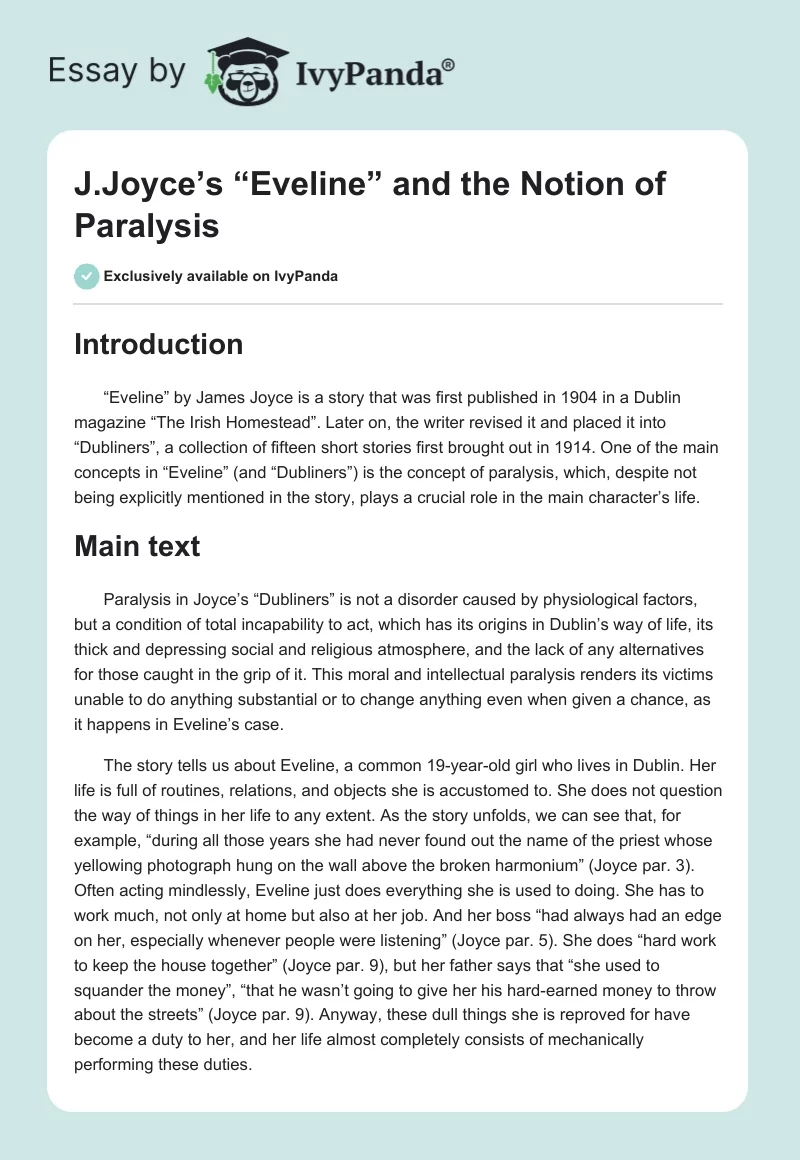Introduction
“Eveline” by James Joyce is a story that was first published in 1904 in a Dublin magazine “The Irish Homestead”. Later on, the writer revised it and placed it into “Dubliners”, a collection of fifteen short stories first brought out in 1914. One of the main concepts in “Eveline” (and “Dubliners”) is the concept of paralysis, which, despite not being explicitly mentioned in the story, plays a crucial role in the main character’s life.
Main text
Paralysis in Joyce’s “Dubliners” is not a disorder caused by physiological factors, but a condition of total incapability to act, which has its origins in Dublin’s way of life, its thick and depressing social and religious atmosphere, and the lack of any alternatives for those caught in the grip of it. This moral and intellectual paralysis renders its victims unable to do anything substantial or to change anything even when given a chance, as it happens in Eveline’s case.
The story tells us about Eveline, a common 19-year-old girl who lives in Dublin. Her life is full of routines, relations, and objects she is accustomed to. She does not question the way of things in her life to any extent. As the story unfolds, we can see that, for example, “during all those years she had never found out the name of the priest whose yellowing photograph hung on the wall above the broken harmonium” (Joyce par. 3). Often acting mindlessly, Eveline just does everything she is used to doing. She has to work much, not only at home but also at her job. And her boss “had always had an edge on her, especially whenever people were listening” (Joyce par. 5). She does “hard work to keep the house together” (Joyce par. 9), but her father says that “she used to squander the money”, “that he wasn’t going to give her his hard-earned money to throw about the streets” (Joyce par. 9). Anyway, these dull things she is reproved for have become a duty to her, and her life almost completely consists of mechanically performing these duties.
She gets the chance to escape from this routine life when she meets Frank and starts dating him. Being “very kind, manly, open-hearted” (Joyce par. 10), Frank introduces a bright contrast to her mundane life. After a quarrel with her father, a man radiating danger of violence towards Eveline even at her current age, she has to date Frank secretly. Her boyfriend proposes escaping to Buenos Ayres together. Eveline dreams about how she would start a new life as a married woman, at long last get some respect, and build her own life.
Her way of living has taken a stronghold of her, though. While looking forward to leaving her home soon, Eveline feels that her existence, though hard, was not “a wholly undesirable life” (Joyce par. 9). At the very last moment, when Eveline is almost ready to leave for Buenos Ayres, she is suddenly paralyzed: she feels unable to do anything, to make a single step. The girl sets “her white face to him, passive, like a helpless animal” (Joyce par. 26), and gives Frank “no sign of love, farewell or recognition” (Joyce par. 26). Even despite dreaming about how Frank would “give her life”, “save her” (Joyce par. 18) before that, she stays.
Conclusion
It can be reasoned that Eveline’s inability to escape is simply social structures and relations acting through her, replacing her personality in that crucial moment. Or perhaps not replacing, but simply rooting deep into her personality throughout her life. Being subjected to various duties and regulations, and treated roughly even in cases where there was not any possibility of her breaking them, the girl has unwillingly made these boundaries part of her very self, and she finds herself unable to do anything about them.
Work Cited
Joyce, James. “Eveline.” The Literature Network, n.d. Web. 2015.


